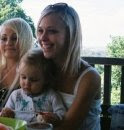 VoiceThread a web based technology, is a collaborative multimedia slideshow that holds images, documents and videos allowing other users to leave comments in five different ways (Dierolf & Frazier, 2008). This web tool has endless possibilities as it encompasses the use of endless slides, allows users to doodle on the slides, includes pictures and typed documents as well as having the ability to be "embedded or exported to other destinations and multiple identities can be created under one account" (Dierolf & Frazier, 2008). Not only does VoiceThread have many features it also allows the user to have control over their privacy settings, allowing them to choose whether to make their files public, allow others to provide comments on the slides while being able to monitor the comments that are posted on the slides (Dierolf & Frazier, 2008). Another fantastic aspect about this program is the application dedicated to educators providing them with various resources and interesting applications to enhance their learning designs within the classroom (Dierolf & Frazier, 2008).
VoiceThread a web based technology, is a collaborative multimedia slideshow that holds images, documents and videos allowing other users to leave comments in five different ways (Dierolf & Frazier, 2008). This web tool has endless possibilities as it encompasses the use of endless slides, allows users to doodle on the slides, includes pictures and typed documents as well as having the ability to be "embedded or exported to other destinations and multiple identities can be created under one account" (Dierolf & Frazier, 2008). Not only does VoiceThread have many features it also allows the user to have control over their privacy settings, allowing them to choose whether to make their files public, allow others to provide comments on the slides while being able to monitor the comments that are posted on the slides (Dierolf & Frazier, 2008). Another fantastic aspect about this program is the application dedicated to educators providing them with various resources and interesting applications to enhance their learning designs within the classroom (Dierolf & Frazier, 2008). ntations up onto the program but can also work collaboratively with others on pre-existing pieces of work. This allows students to comment on each others work helping to enhance the quality of information being presented through expressing new ideas, making corrections and providing/receiving constructive feedback. Students can also create their own story books while providing various effects such as narration. It becomes evident that the use of VoiceThread within the classroom is underpinned by Kearsley & Shneiderman's Engagement Theory (1999). Throughout the use of the web tool students are continuously engaging with each other collaboratively, sharing their ideas and expressing feedback to each other on certain aspects of the presentation. During this students are creating their own understandings and applying this within their project (slide on VoiceThread) (Kearsley & Shneiderman, 1999). Then finally they are donating this to the wider community through making it available to others to access and learn from (these may be other classes within their school, friends or family) (Kearsley & Shneiderman, 1999).
ntations up onto the program but can also work collaboratively with others on pre-existing pieces of work. This allows students to comment on each others work helping to enhance the quality of information being presented through expressing new ideas, making corrections and providing/receiving constructive feedback. Students can also create their own story books while providing various effects such as narration. It becomes evident that the use of VoiceThread within the classroom is underpinned by Kearsley & Shneiderman's Engagement Theory (1999). Throughout the use of the web tool students are continuously engaging with each other collaboratively, sharing their ideas and expressing feedback to each other on certain aspects of the presentation. During this students are creating their own understandings and applying this within their project (slide on VoiceThread) (Kearsley & Shneiderman, 1999). Then finally they are donating this to the wider community through making it available to others to access and learn from (these may be other classes within their school, friends or family) (Kearsley & Shneiderman, 1999).The use of this tool within the classroom also takes a constructivist approach as the learning and knowledge that is being undertaken is resting within a diversity of opinions (Siemens, 2004). This can become evident through the diversity of opinions and knowledge that may be expressed by others on a particular topic presented within the VoiceThread, these opinions can then spark new interests or learning paths. This is allowing students to make decisions about their learning, choosing what to learn and how to acquire the information and knowledge needed (Siemens, 2004).
VoiceThread proves to be an effective web tool that can be introduced within the classroom. Although when doing this the educator must ensure that students are safe and create the one account that the students can access and have their own identities under this. This means no photographs of the students (if made public) and continuous monitoring must be done!
I have quickly done up a slide comprised of photos that were used within a recent unit on "Natural Disasters." There is no audio due to my lack of microphone, so I have just played around with some of the applications!




No comments:
Post a Comment